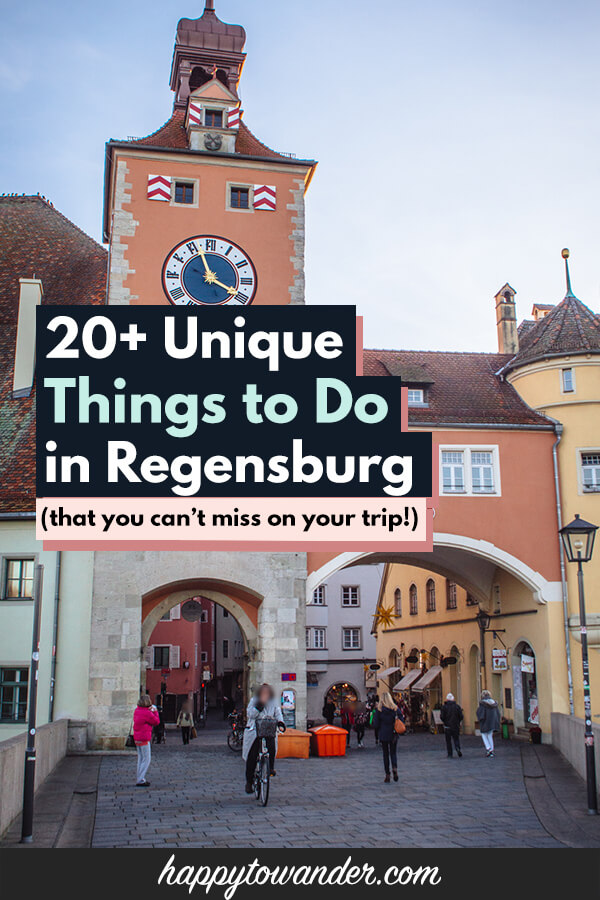*FYI - this post may contain affiliate links, which means we earn a commission at no extra cost to you if you purchase from them. Also, as an Amazon Associate I earn from qualifying purchases. Check out our Privacy Policy and Disclosure. for more info.
Located along the gorgeous Danube River, Regensburg is a Bavarian gem with plenty to flaunt, from a UNESCO World Heritage Old Town and the oldest bridge in the country to an epic palace, ancient city walls, and even the world’s oldest bratwurst stand (still flinging Bratwurst after 500 years).
The point is: Regensburg has range, and if you’re curious what things there are to do there, then this post is for you.
Read on for a list of the best things to do in Regensburg, whether you’re looking for museums and memorials or historic hot dogs and hats.
… Like I said, range... and over 2000 years of history to nerd out about. I have a feeling you’ll like this one!
1. Wander Around Regensburg Altstadt (Old Town)
The first time I visited Regensburg, what struck me most was just how aggressively pretty the Old Town was. One step inside the (UNESCO Heritage) Altstadt and you’re greeted with medieval streets adorned with pastel buildings, charming squares, and quaint cafes – pretty much around every corner.
While the best way to appreciate Old Town is simply by strolling around and taking in the sights, I’ll be sharing some of the top attractions below.
PS: If you don’t mind a shamelessly touristy way of seeing the Old Town, there’s a little sightseeing train you can hop on here.

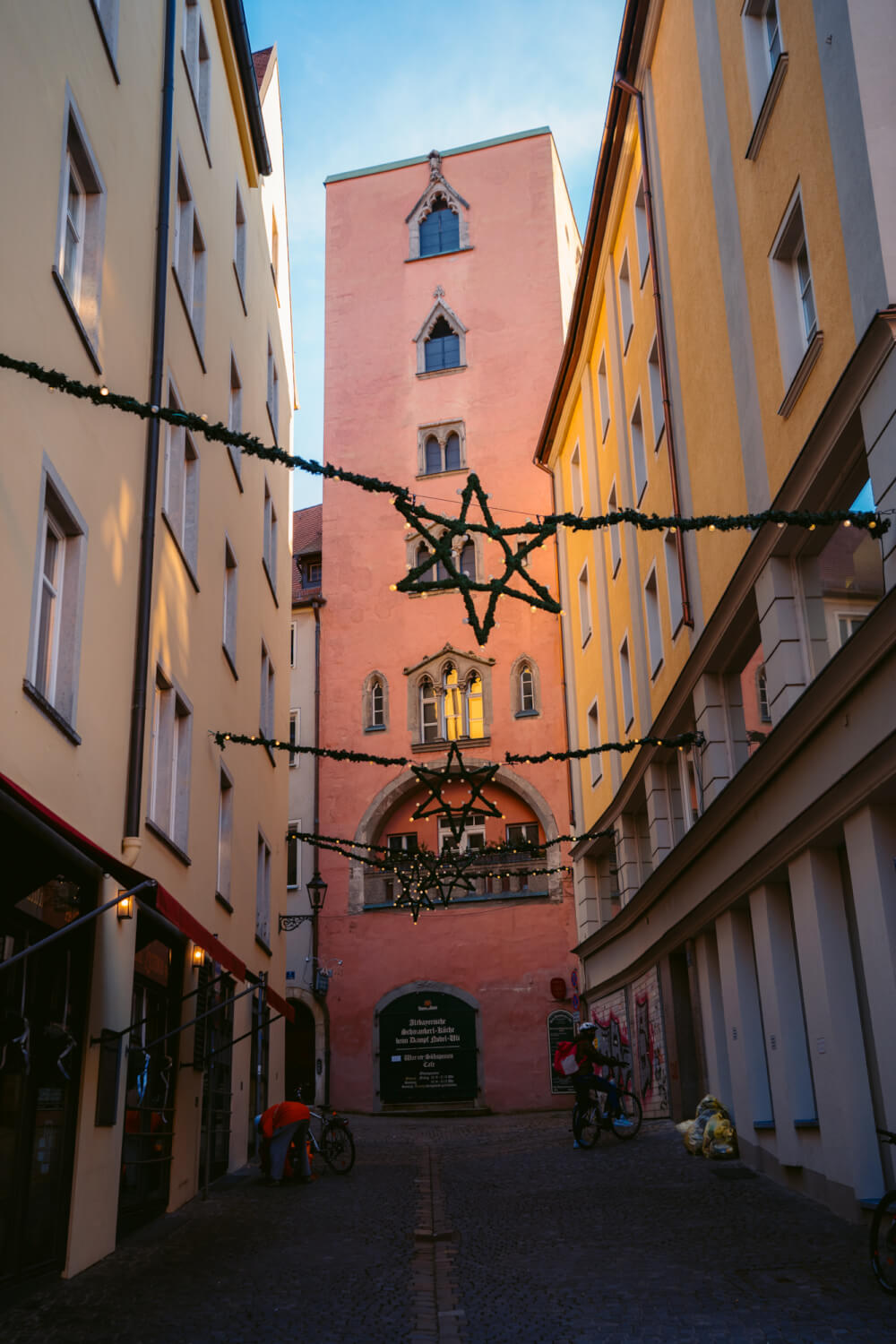
2. Steinerne Brücke (Stone Bridge)
Now, the most famous attraction in Regensburg is probably the Steinerne Brücke (Stone Bridge).
This 12th-century bridge spans the Danube and offers spectacular views of the city and the river. Fun fact: up until the 1930s, it was actually the only bridge in Regensburg, so for more than 800 years!
Adding to its historic bragging rights, this bridge also served as the model on which many other famous bridges were based, including London Bridge in London, the Pont d’Avignon in Avignon and the Judith Bridge (which the Charles Bridge replaced in a similar style) in Prague.
These days, it’s not only a pleasure to stroll across, but also to photograph. Your visit to Regensburg definitely wouldn’t be complete without approximately 500 photos here, so be sure to stop by.
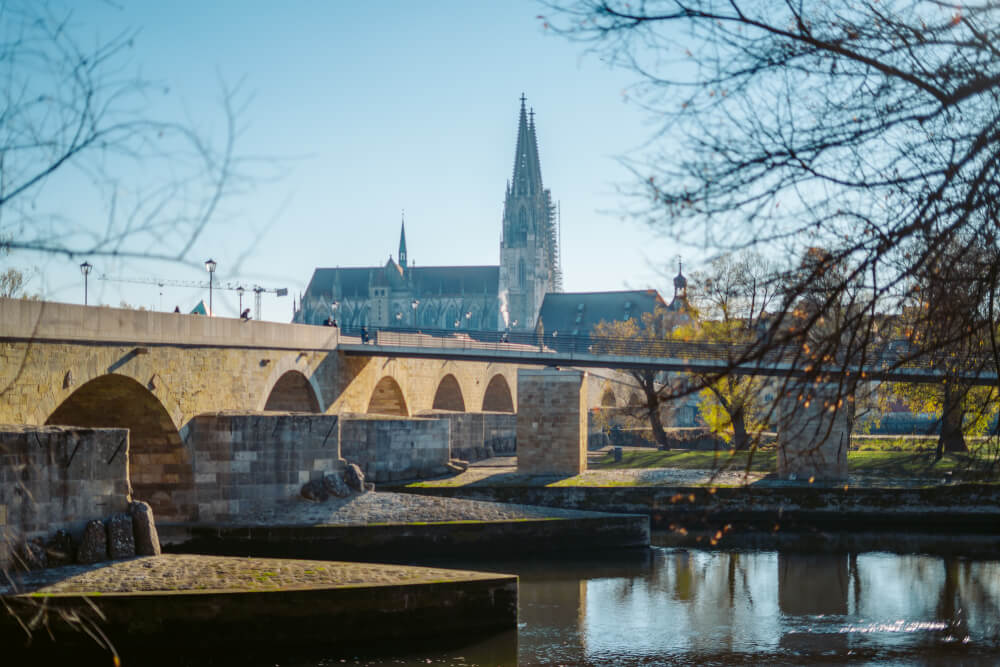
3. Dom St. Peter (Regensburg Cathedral)
Regensburg is home to a shocking number of churches, so you’re really spoiled for choice as far as houses of worship go…
But the most famous must-see is probably Dom St Peter, also known as Regensburg Cathedral or St. Peter’s Cathedral.
This free-to-enter cathedral is a masterpiece of Gothic architecture, with stunning stained glass windows, a cool astronomical clock, and a crypt with royal tombs.
The cathedral’s construction began in the mid-13th century and was largely completed by the early 16th century, although various additions and renovations have been made over the centuries. Some of the stained glass windows date back to the 13th and 14th centuries and are considered masterpieces of medieval art.
Regensburg Cathedral is also home to one of the largest organs in Germany, which is frequently used for concerts and religious services.
These days, it remains one of the most popular places to visit in Regensburg, so make sure you don’t miss it.
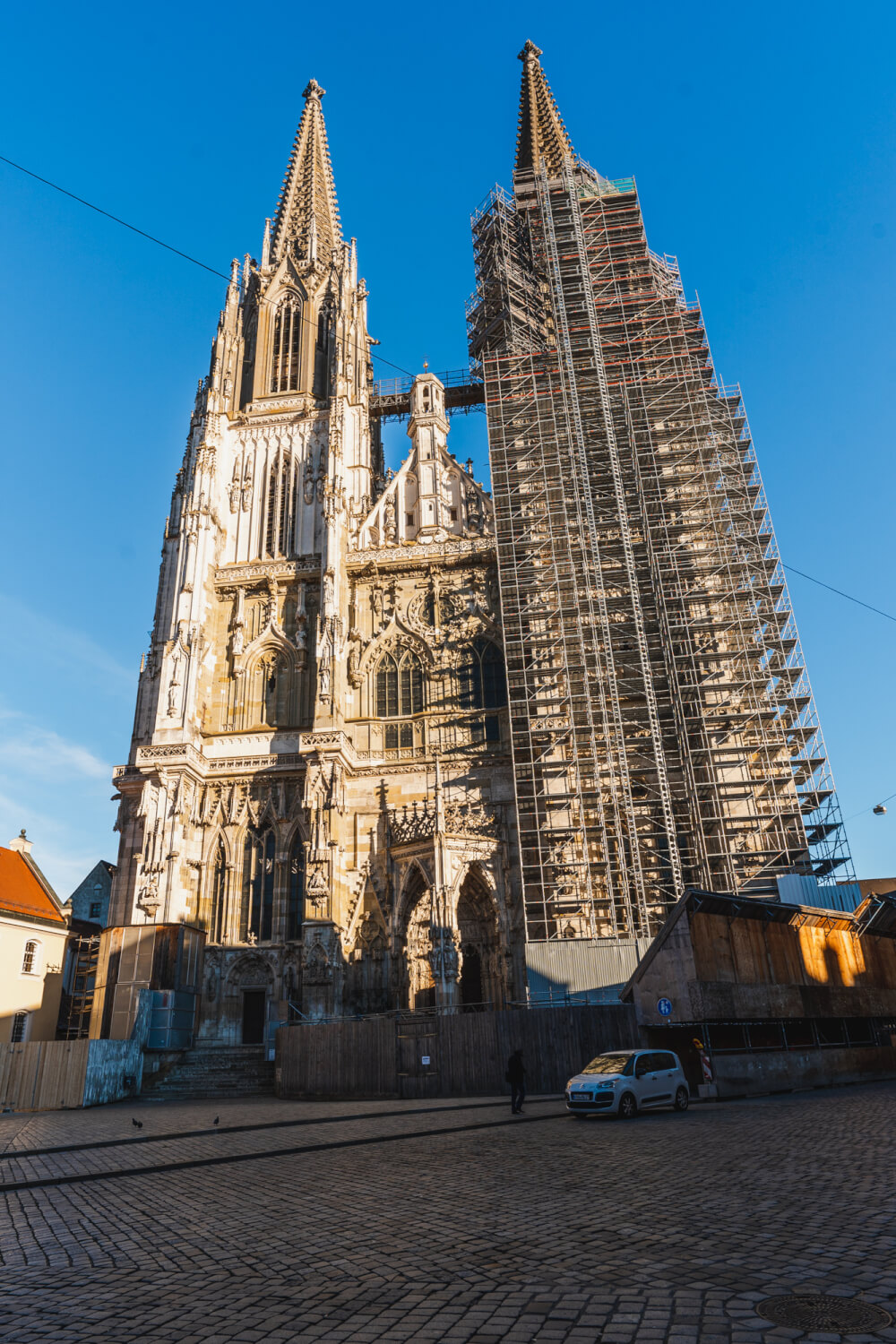
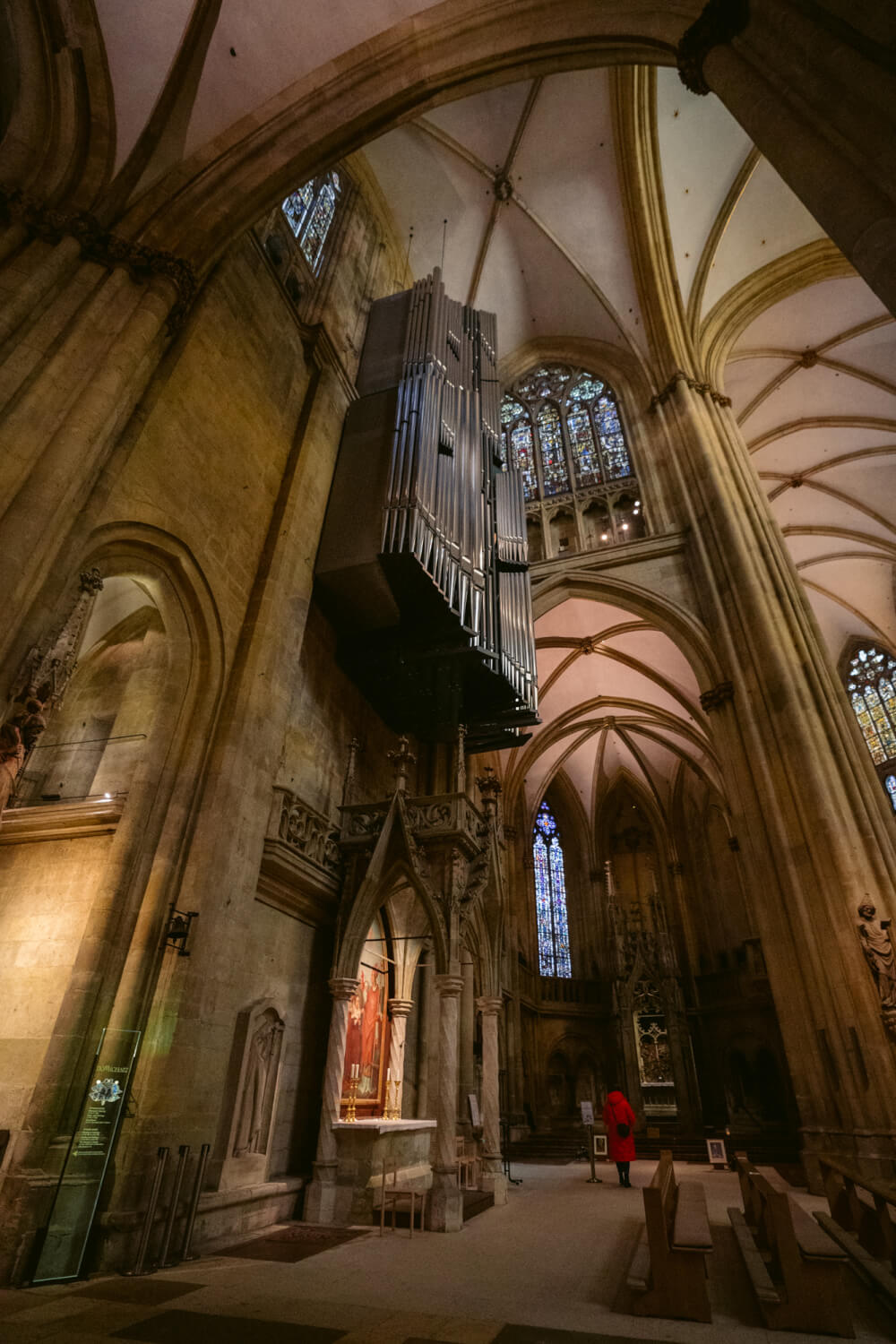
4. Alte Rathaus
The Alte Rathaus is the Old Town Hall of Regensburg, a striking historical and architectural gem that should not be missed while you’re exploring the town.
Constructed in stages beginning in the early 14th century, this remarkable building served as the seat of the city council and was also the site of the Imperial Diet (Reichstag) of the Holy Roman Empire between 1663 to 1806.
One of the most distinctive features of the Alte Rathaus is its Gothic Town Hall Tower, which dominates the cityscape with its crenellated top and historic clock. This tower, along with the Baroque Council Chamber and the grand Imperial Hall (Reichssaal), forms the core of the town hall complex.
Inside the Alte Rathaus, you can explore the interrogation room and the medieval dungeon, which offer a fascinating glimpse into the judicial practices of the time. The building also houses numerous exhibits that showcase the history of Regensburg, the Holy Roman Empire, and the town hall itself.
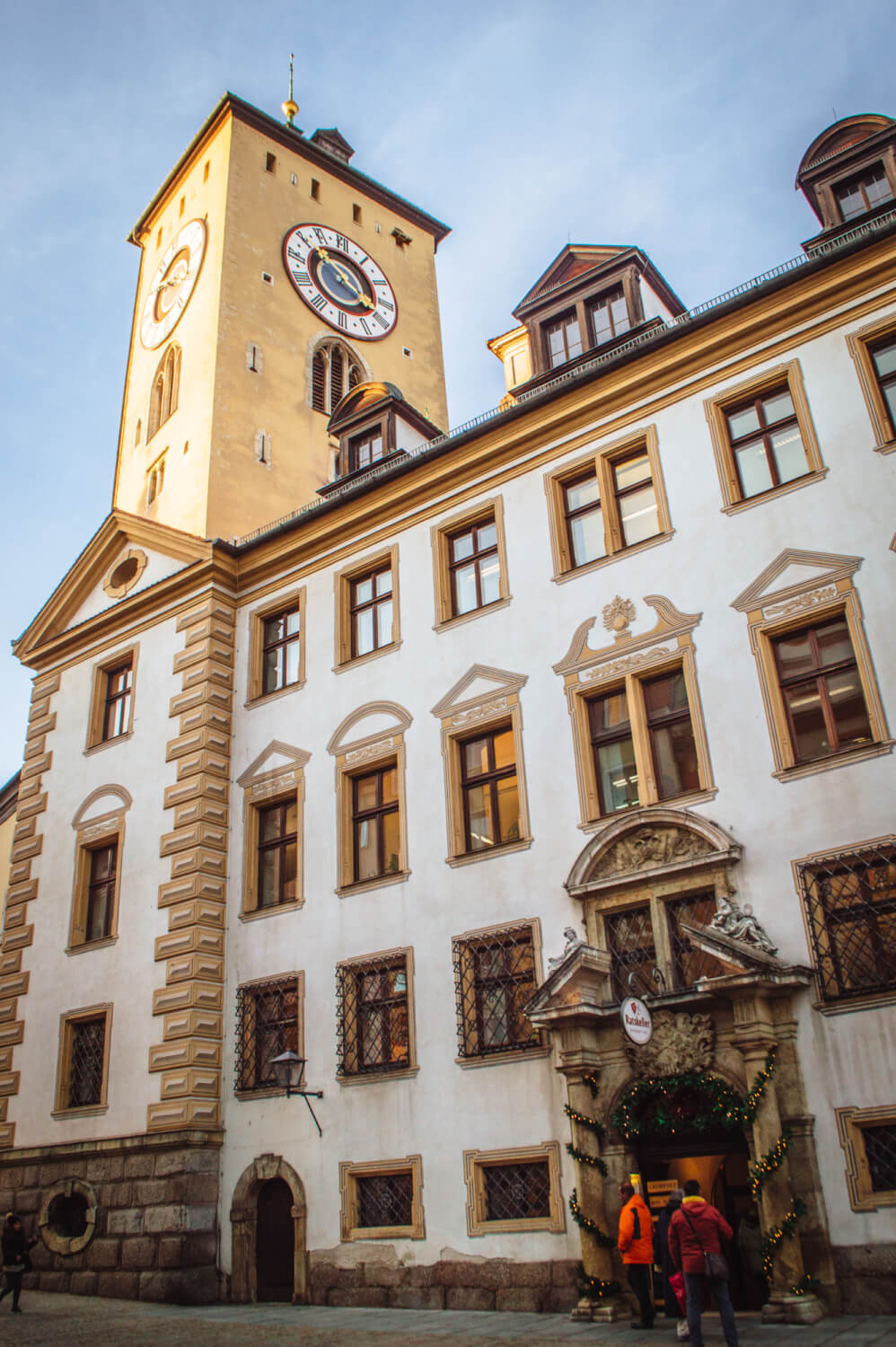
5. Goliath House (Goliathhaus)
Another cool must-see in the Altstadt is the famous Regensburg Goliathaus, which dates back to the 13th century. As you might guess from its name, this intriguing medieval building is adorned with unique 16th century frescoes of the biblical story of David and Goliath.
Originally constructed as a residential and commercial building for wealthy merchants., its design reflects the typical medieval layout with a blend of Romanesque and Gothic elements… though it’s the fesco-decked facade that most visitors come for these days.
While its widely believed that the building is called the Goliath House because of the fresco, it was at one point the home of the Goliards – a clergy group known for writing satirical poetry during the 12th and 13th centuries. Perhaps Melchior Bocksberger was thinking about this when he painted the mural in 1573, or perhaps he really just liked the story of David and Goliath.
Either way, it’s definitely worth a look!
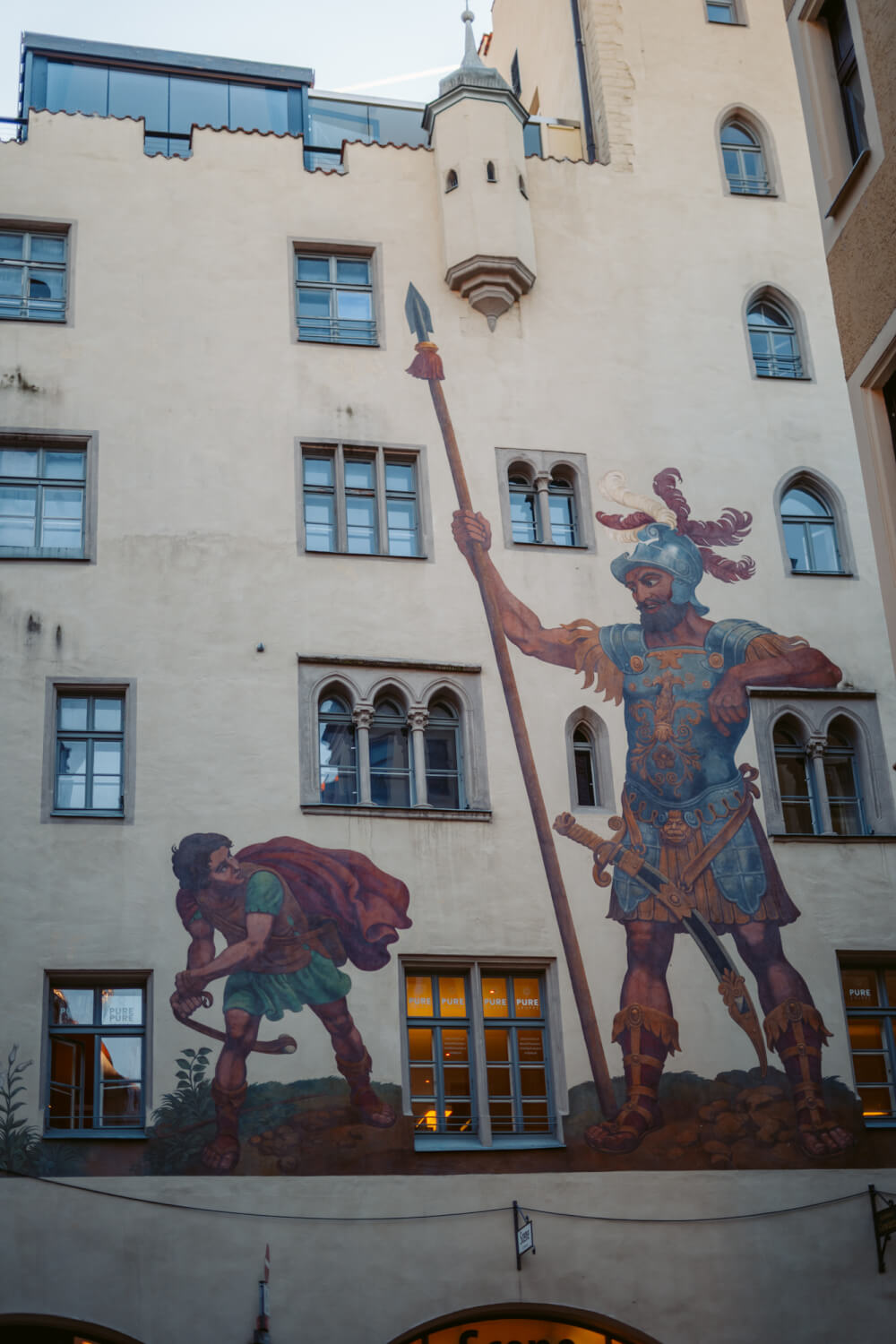
6. St Emmeram Palace (Schloss Thurn und Taxis)
Another highlight of Regensburg is its own posh palace, the gorgeous St Emmeram Palace, AKA Schloss Thurn und Taxis.
The site of St. Emmeram Palace was originally occupied by the Benedictine Abbey of St. Emmeram, which was founded in the 8th century. In the early 19th century, following the secularization of church properties, the abbey was acquired by the Thurn und Taxis family, a prominent noble family known for their role in developing the European postal system!
Under the ownership of the Thurn und Taxis family, the former abbey was transformed into a palatial residence, with renovation and expansion works blending various architectural styles, including Baroque, Rococo, and Neoclassical elements, to create the lavish palace we see today.
Today the palace remains the primary residence of the Thurn und Taxis family and is also open to the public, with palace tours providing a fascinating glimpse into their ritzy history and lifestyle. Visitors can tour the lavishly decorated state rooms, a museum that showcases the family’s history, the former abbey church which is now a private chapel and the extensive gardens surrounding the palace.
NOTE: If you time your visit for the holiday season, make sure you pay the entry fee to come see the Christmas market here. It’s honestly one of the most beautiful Christmas markets in Europe that I’ve been to!
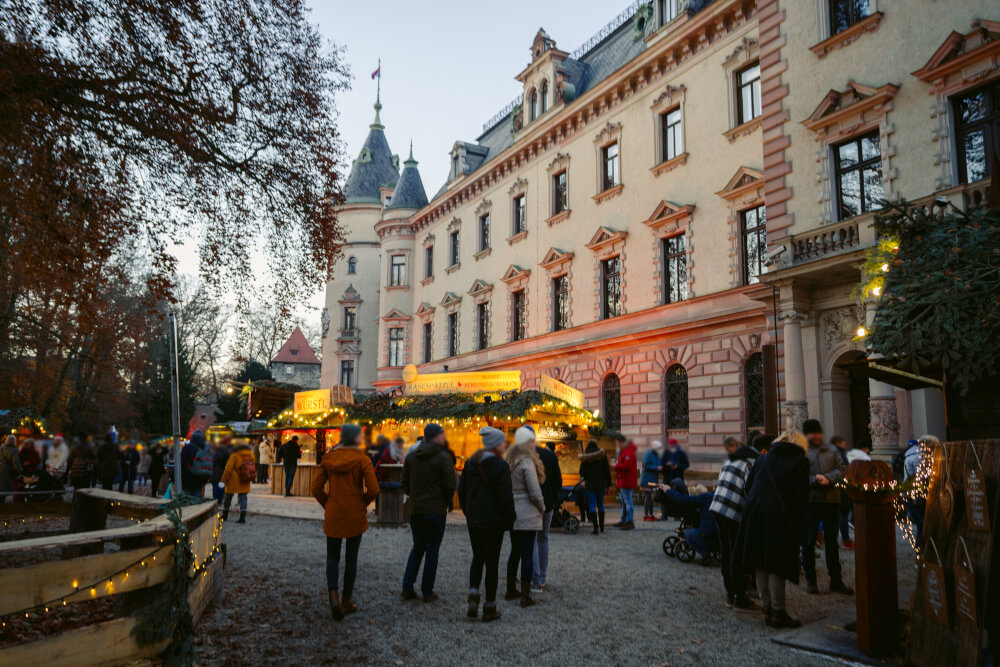
7. Enjoy a coffee with a view
One of my favourite ‘hidden in plain sight’ gems that I discovered on my last trip to Regensburg was the epic rooftop terrace at the Galleria Kaufhof Neupfarrplatz – the perfect place to caffeinate with a view.
During my visit, this was a standard department store cafeteria that just happened to have an incredible view. Since then, the department store has shut and reopened, with the rooftop gaining new life every so often as a fun event space.
I haven’t been able to tell if the terrace is open again to the public, but just know that it used to be at the top of the Galleria Kaufhof at Neupfarrplatz, so it couldn’t hurt to pop in for a look (or ask someone).
Side note: please let me know in the comments if you’ve gone there recently – I’d love to update this post with accurate info.
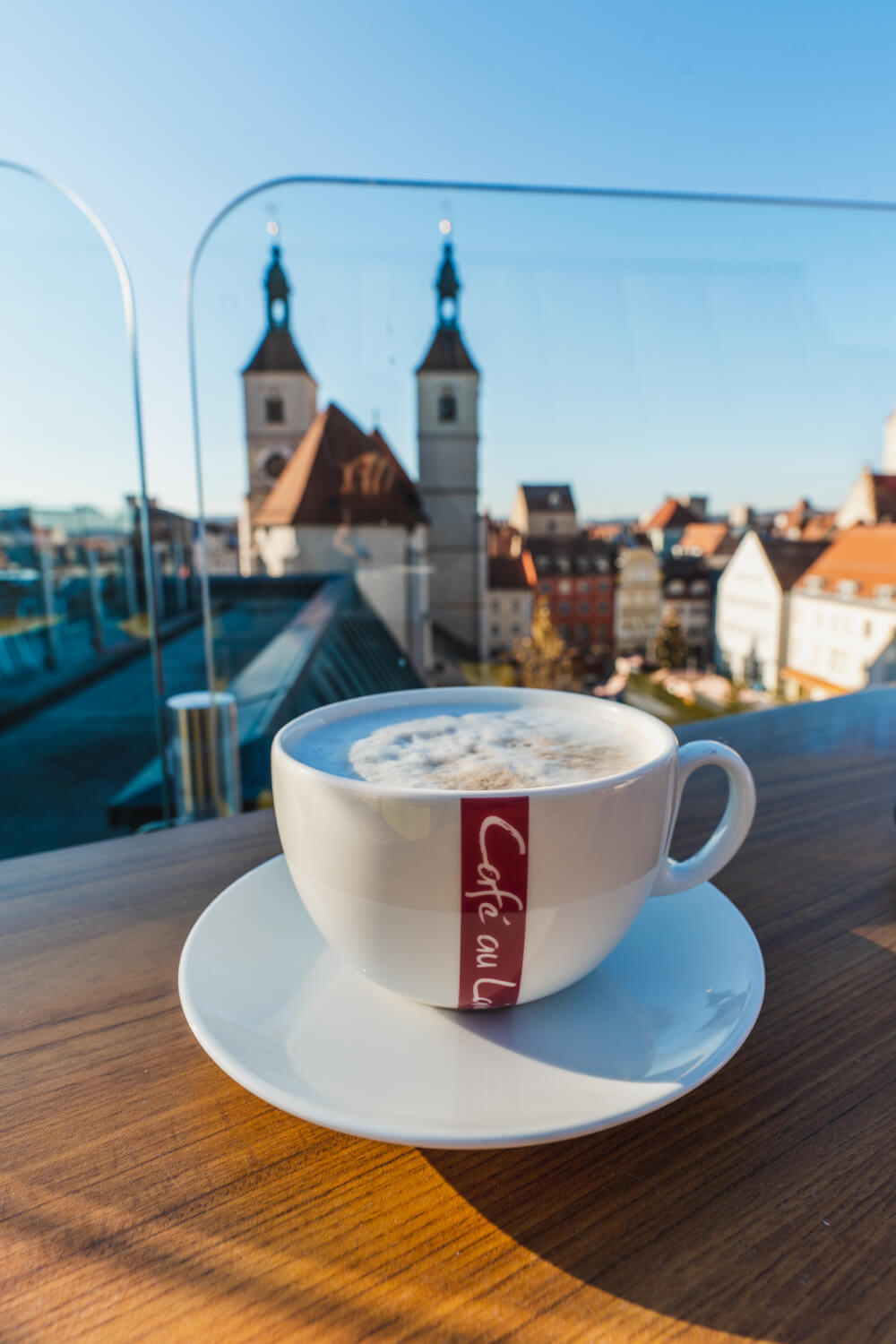
8. Document Neupfarrplatz
For those interested in local history (including the city’s darker chapters), Document Neupfarrplatz is an open-air museum all about the the life and fate of Regensburg’s Jewish community.
A little context: in the early medieval period, Neupfarrplatz was the site of Regensburg’s Jewish quarter, home to a vibrant community that contributed greatly to the cultural and economic development of the city… that is, until the tragic events of 1519, when the Jewish population was expelled, and their synagogue and homes destroyed. The area was then transformed into a public square, and Neupfarrkirche (church) was built on the site of the former synagogue.
This bleak chapter of the city’s history would come back into the spotlight centuries later in the 1990s, during excavations for the construction of a shopping center, when significant archaeological discoveries were made beneath Neupfarrplatz. These excavations unearthed the foundations of the medieval synagogue, homes, and other structures, including the remains of a Roman legionary camp from 179 AD!
Today, visitors to Document Neupfarrplatz can explore part of the excavation area where they’ll find interesting interactive displays, historical documents, and artifacts which offer insight into the lives of those who lived here. NOTE: You can only visit via a guided tour. Check out ticket pricing and further details here.
9. Historische Wurstküche (Historic Sausage Kitchen)
After all that sightseeing, you might start feeling a little lightheaded. My prescription? Historic sausage. Why not?
Yes, you heard me – a fun foodie activity in Regensburg to put on your list is a stop at at the Old Sausage Kitchen, AKA Germany’s oldest restaurant (and possibly the oldest sausage stall in the world).
Established in 1135 AD, the building was originally a construction office during the building of the Stone Bridge, which was completed in 1146. Once the bridge was finished, the small building was repurposed as a food stand to cater to the workers and traders who frequented the bustling trade route.
The food served here used to be boiled meat, but when it was taken over in 1806 by the family who currently run it, they switched to traditional Bavarian sausages, which are grilled over an open beechwood fire giving them a distinctive smoky flavor. These sausages are typically served with sauerkraut and a generous dollop of homemade mustard, all nestled in a fresh roll. This simple yet flavorful dish has remained largely unchanged over the centuries, preserving a culinary tradition that draws both locals and tourists alike.
Granted, the service here is frosty at best, but the sausages are tasty and the building itself is aggressively cute. Definitely worth it, in my eyes.
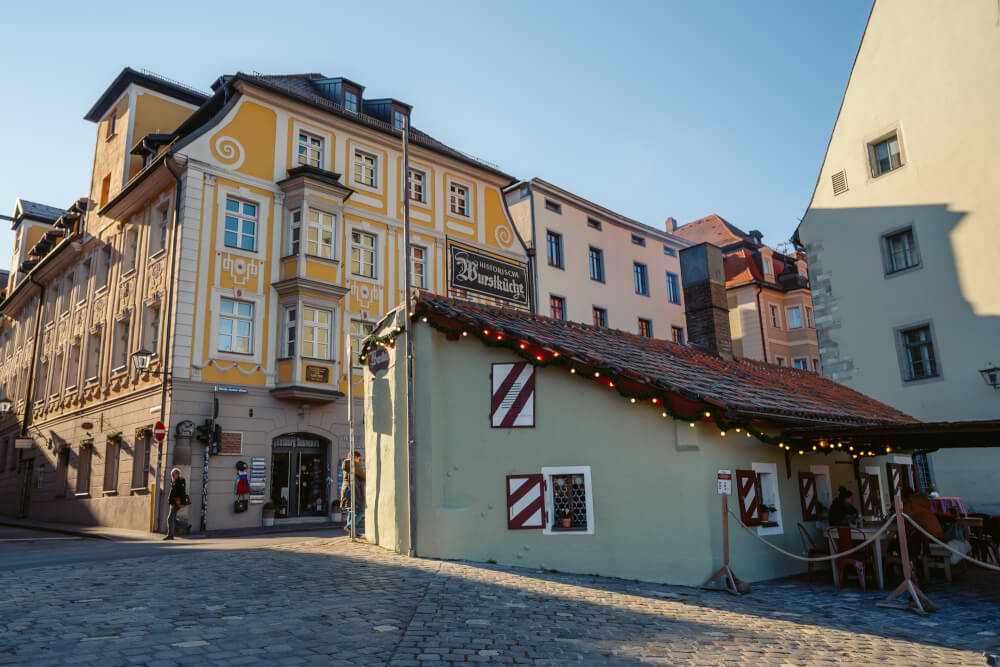
10. Schottenkirche (Scots Monastery)
Keen to check out more (non-sausage related) historic sights in Regensburg? The Schottenkirche, also known as the Scots Monastery, is a historic and architecturally significant church which was founded in the 12th century by Irish monks…
Now, I know what you’re thinking, “Why is it called the Scots Monastery if they were Irish?!” Well, the name “Schottenkirche” derives from the Latin “Scoti,” which was the term used at the time for the Irish. Naming confusion aside, this is a beautiful church and an excellent example of Romanesque style.
A highlight of the church is its distinctive western façade adorned with intricate carvings, including the famous “Schottenportal,” a richly decorated portal depicting scenes from Christian iconography and Celtic motifs. Definitely worth a quick stop to check out!
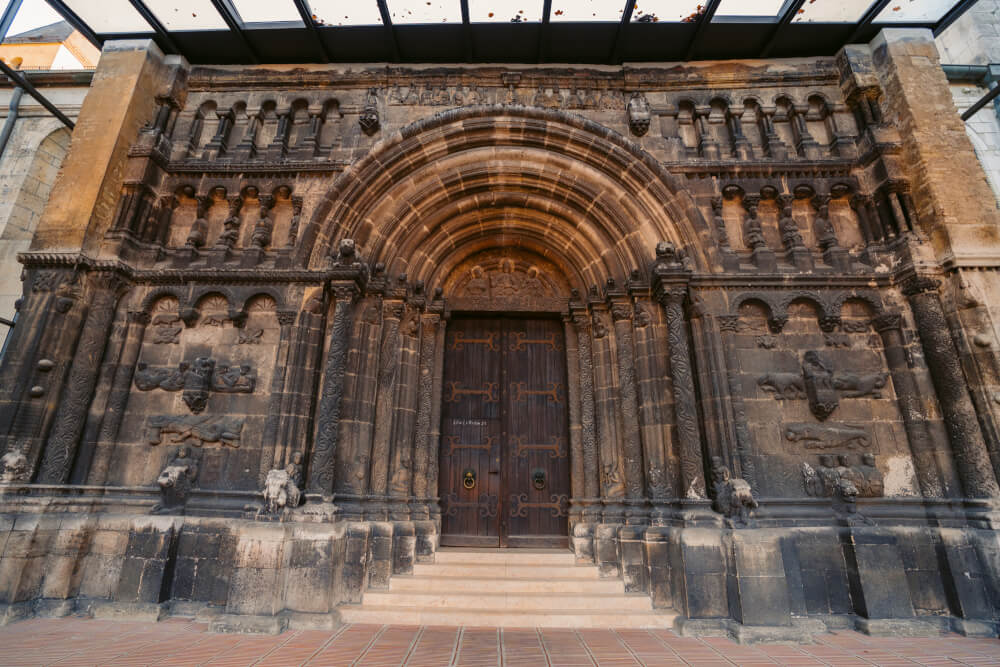
But be sure to visit the inside too:
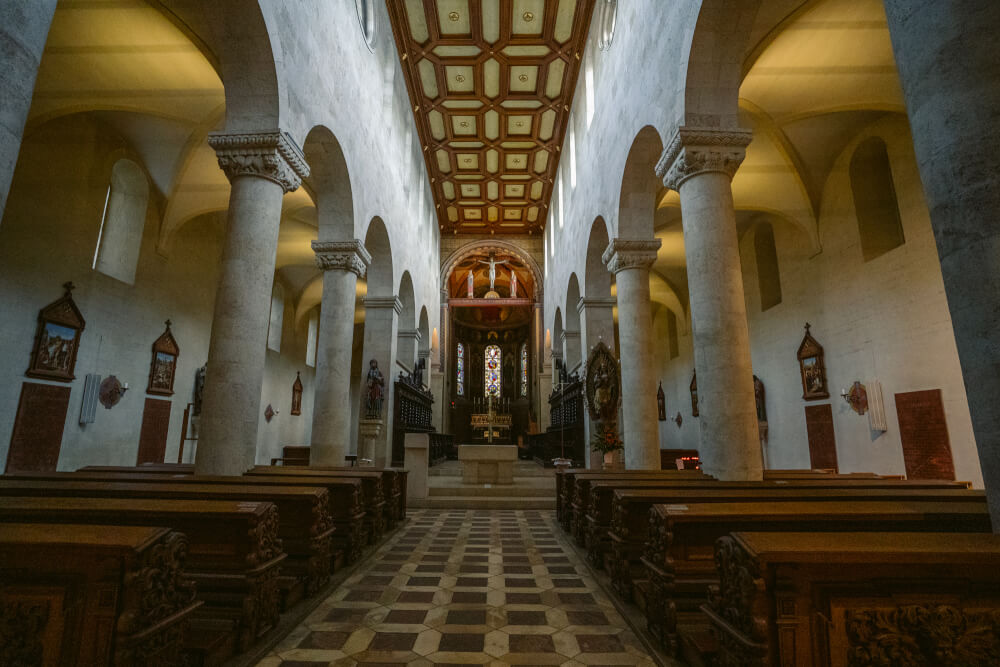
11. Haus der Bayerischen Geschichte (Bavarian History Museum)
And if you want to learn more about the history of Bavaria while you’re in Regensburg, be sure to head to the Bavarian History Museum.
Opened in 2019, this museum offers an engaging and interactive journey through the region’s past, from its early beginnings to the present day, all housed in a sleek and modern building (by Bavarian standards anyway).
Inside, visitors can explore a wide array of displays that highlight significant events, cultural developments, and notable figures in Bavarian history, with a variety of multimedia presentations, including films, interactive installations, and historical artifacts that bring history to life in an immersive way.
Themes covered include the evolution of Bavarian identity, the impact of industrialization, and the region’s role in national and European contexts, so be sure to stop by for some more context on the local area.
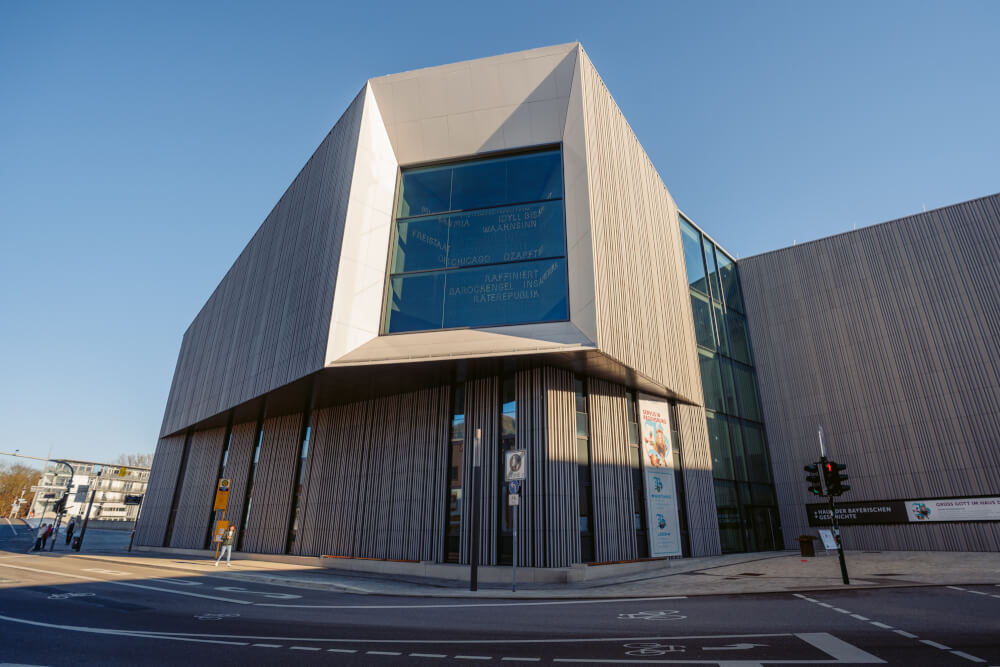
12. Regensburg Historische Museum (Regensburg History Museum)
And, of course, if you’re more interested in the specific history of Regensburg then there’s the Regensburg History Museum as well!
Housed in the former Saint Ulrich’s Church near the iconic Regensburg Cathedral, this museum is a treasure trove of artifacts and exhibits that chronicle the rich history of Regensburg, from prehistoric times through to the modern era.
Highlights include Roman relics that testify to Regensburg’s importance as a Roman stronghold and medieval artifacts that reflect its prominence during the Holy Roman Empire. There are also Renaissance and Baroque pieces that illustrate the city’s economic prosperity in later periods, as well as impressive displays of art like religious sculptures, paintings, and intricate goldsmith works to ooh and ahh over.
All in all, tons of stuff to ogle.
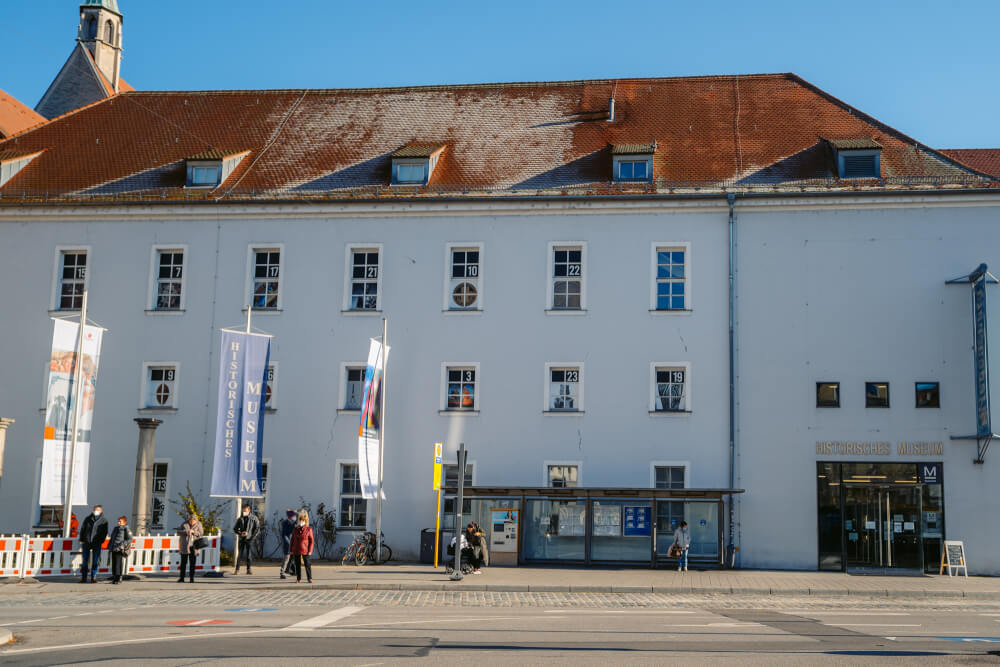
13. Porta Praetoria
Now, Regensburg is best known as a medieval city, but history geeks should know that there are still little remnants of the city’s Roman roots as well. One such spot can be found at the Porta Praetoria, a Roman gate from the 2nd century.
Constructed around 179 AD, this impressive gateway once served as the northern entrance to the Roman military camp, Castra Regina, which was established to protect the northern frontier of the Roman Empire. As one of the oldest surviving stone structures in Germany, the Porta Praetoria stands as a testament to Regensburg’s strategic importance during Roman times.
Discretely tucked away on a quiet alley, this Regensburg attraction doesn’t offer much besides a cool photo/ogling opportunity, but I’d recommend a quick stop if you’re interested in history.
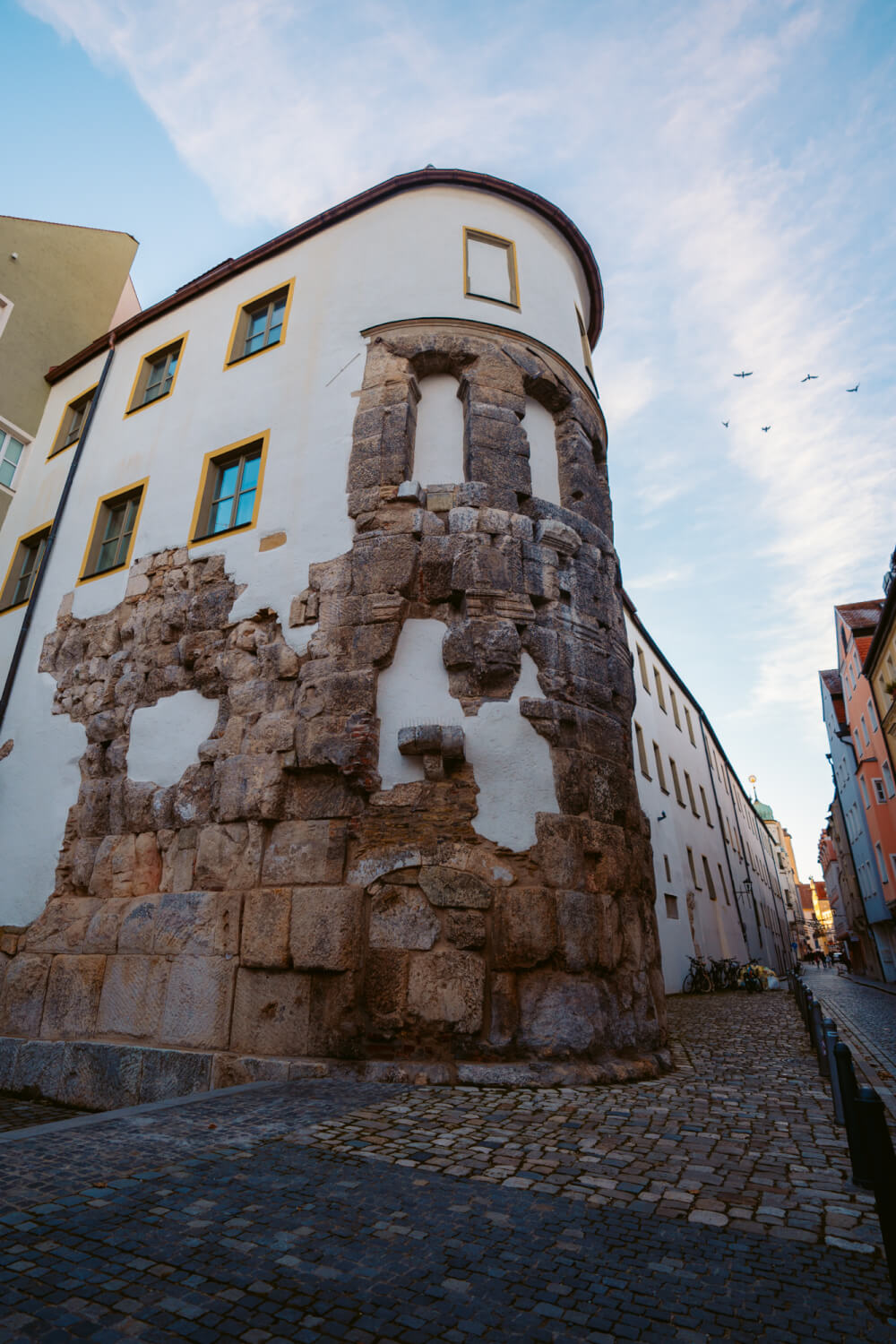
14. Scope out Regensburg’s Old City Walls
Another super cool hidden gem I came across on my recent visit was the Old City Walls display at Document Legionslagermauer.
Document Legionslagermauer is actually located in the basement of the Dachau Square car park, and showcases a well-preserved section of the Roman legionary camp, Castra Regina, which was established around 179 AD. The display is part of the larger historical complex that highlights the significance of Regensburg as a crucial military outpost in the northern frontier of the Roman Empire.
If you want to hunt down all the different Roman historical sites in Regensburg then you can check out the whole map and info booklet here. It would make for a perfect day of exploring if you’re really into the Roman historical side of the city!
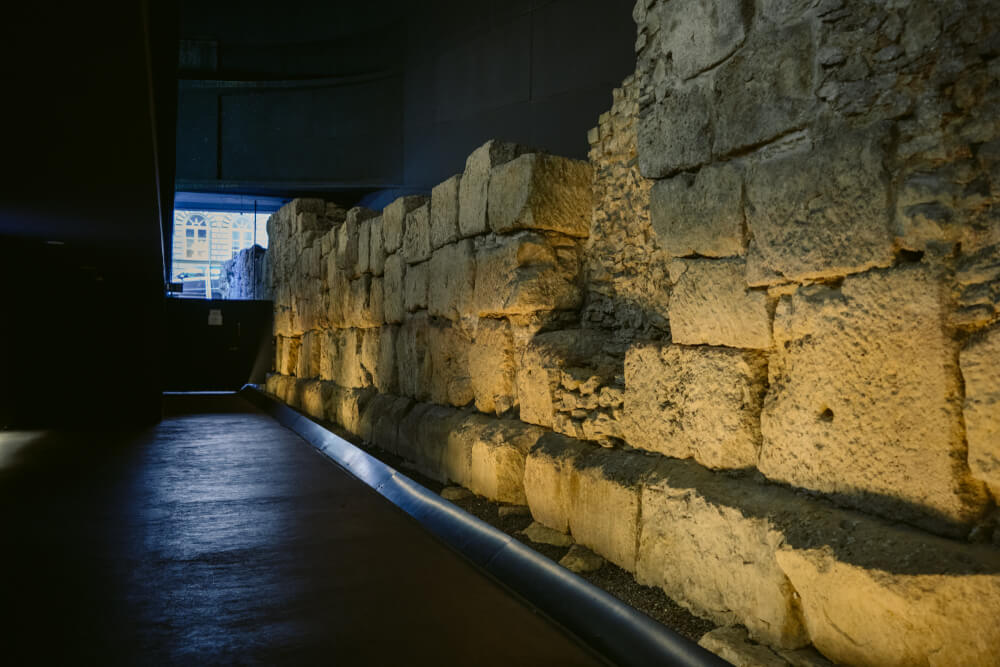
15. Visit German’s first coffee house
Yes, as you probably pieced together by now, Regensburg is a city full of many firsts, so here’s another – Germany’s first coffee house!
You can find this gem at Cafe Prinzess, which takes back to 1686. These days, they offer a range of delicious chocolates and pastries, making it a great place for a little coffee break. Just be warned that the interior is fairly small and there’s not a ton of space to sit, so if you find a free table, be sure to nab it.
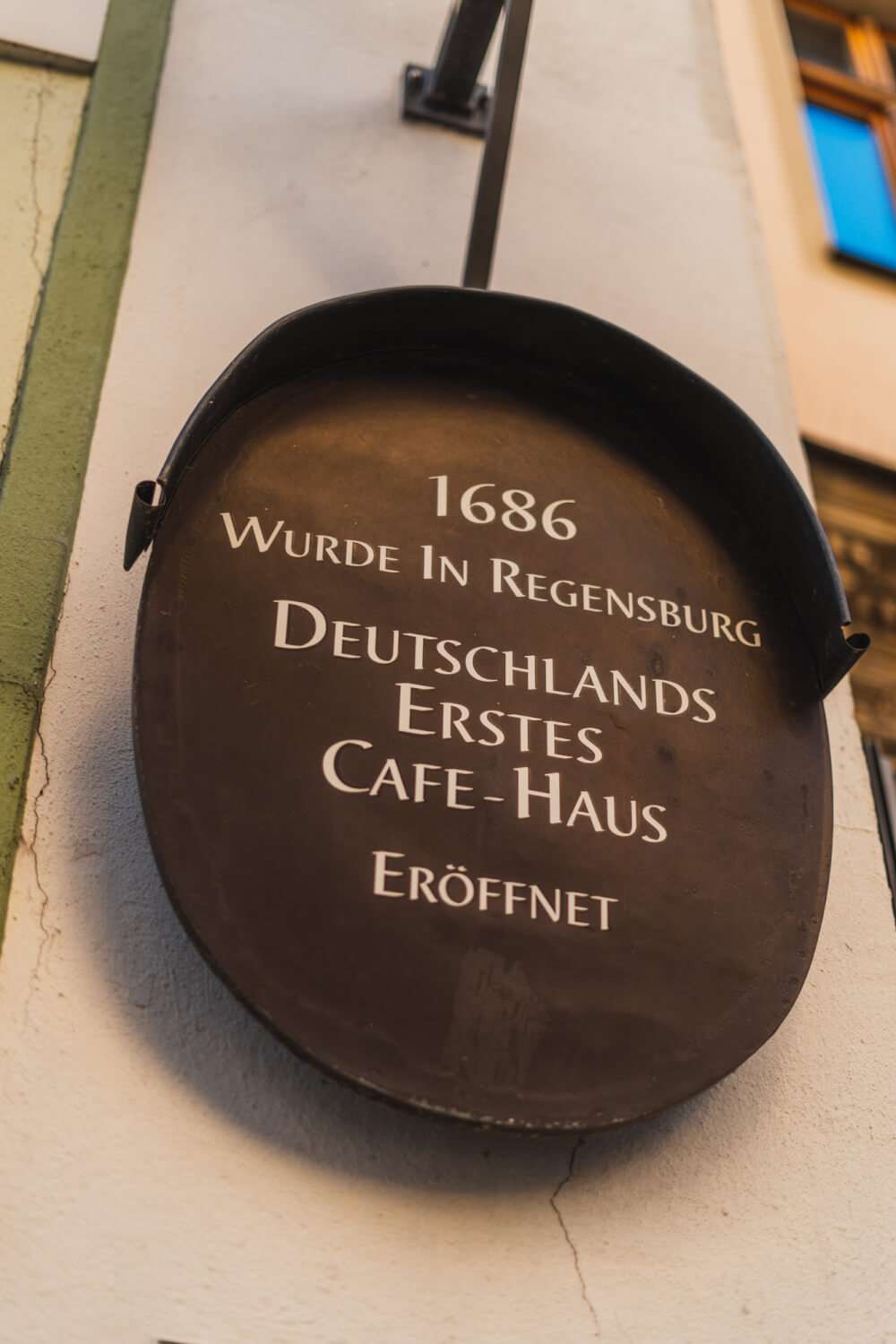

16. Admire some amazing hats
Niche, I know, but one of the most unique shops to visit in Regensburg is Der Hutmacher am Dom… especially because these are the very hat makers who produced one of the most iconic hats in (recent-ish) film history – the Mad Hatter hat from the 2010 Alice in Wonderland movie!
This shop has been around since 1934 (although it was at a different location even earlier) and has earned a reputation over the years as a fine maker of gorgeous hats… meaning a visit inside is either a fun perusal opportunity (if you’re not a hat person) or a financially dangerous expedition if you are. In either case, definitely be sure to look around – it’s located right by Dom St Peter.
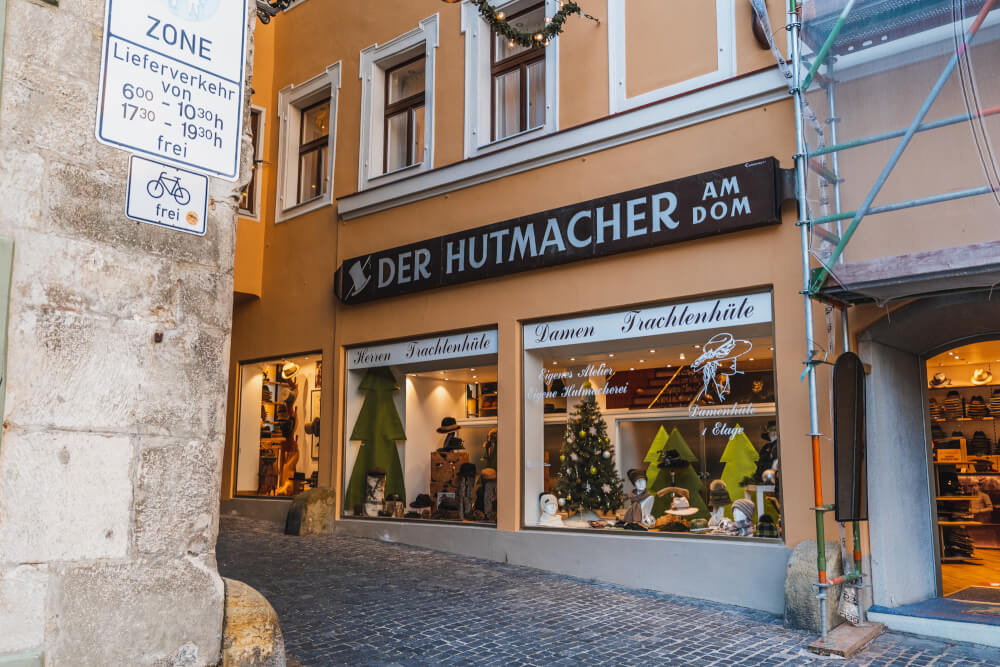
17. Stadtamhof
Just across the Stone Bridge, you’ll find the charming district of Stadtamhof, which is filled with (as you might have expected) picturesque houses and plenty of inviting restaurants.
I’d definitely make sure you take some time to explore this part of the city, because it’s effortlessly adorable.
Some highlights include…
- Andreasstadel: A former salt warehouse that’s now a cultural center along with a hotel, café, restaurant, and cinema to check out
- St. Catherine’s Hospital: The original Hospital Church of St. Katharina is now a large complex housing a nursing home along with a brewery and beer garden, parish church and the hospital archive
- St. Mang: A beautiful Baroque, Gothic and Rococo style church that dates back to the early medieval period
- Graffiti Walls: Along the western end of Stadtamhof are a series of graffiti walls also worth seeing

18. Enjoy Regensburg’s many green spaces
Apart from its dizzying array of historical structures and picture-perfect architecture, one of the best features of Regensburg is its abundance of lush green spaces.
So, here are some places to enjoy Regensburg’s green side:
- Botanischer Garten der Universität (Botanical Garden of the University of Regensburg): The botanical gardens of the university are beautiful and open every day except Saturday during summer. There are a variety of different themed sections to explore
- Stadtpark: Regensburg’s main state park is also lovely, plus it’s both the oldest and largest park in the city. It contains a pretty pond, a puppet theater, playground, a chapel and a cemetery. Just nearby is the equally charming Herzogspark next to the river, which contains a medieval tower and multiple planted gardens including a Renaissance garden and a Shakespeare garden!
- Westbadweiher: A bit further out of the city center but still on the banks of the river is this large park surrounding a small lake. Also known as the Donaupark, this is a great spot for leisurely walks surrounded by nature
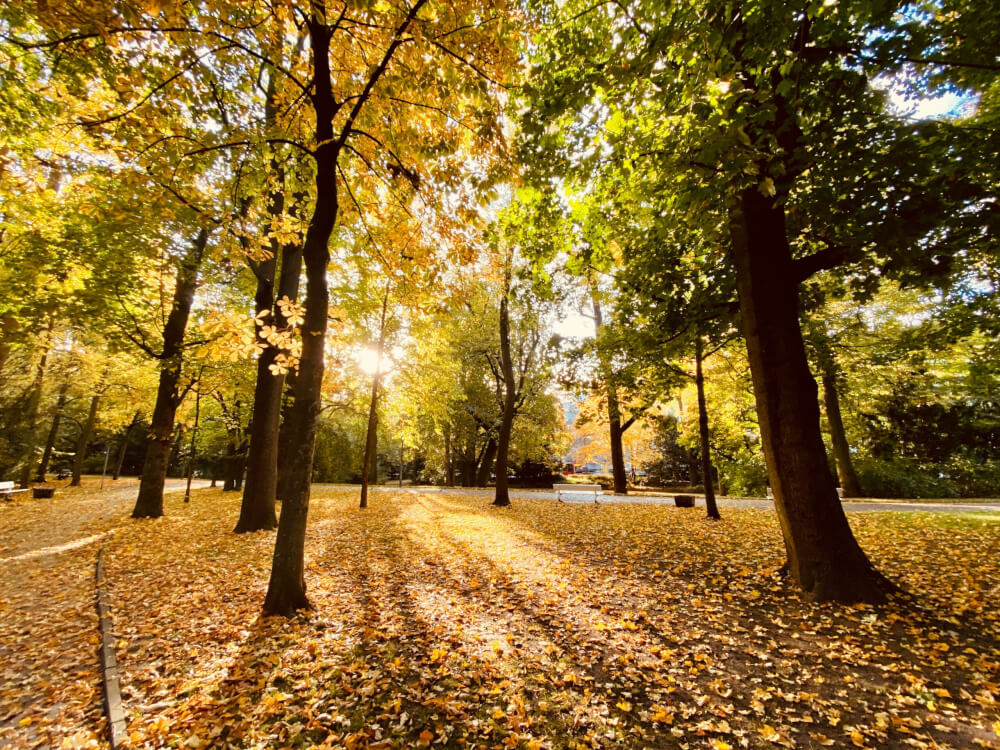
19. Kepler Memorial House (Kepler-Gedächtnishaus)
For space nerds, another Regensburg attraction to consider is the Kepler Memorial House, the former residence of the renowned astronomer Johannes Kepler, best known for his work on the three laws of planetary motion which laid the groundwork for the field of celestial mechanics.
Located in the heart of Regensburg’s Old Town, this house holds significant historical importance as it was Kepler’s final residence. Luckily for space nerds, the house has been meticulously preserved and transformed into a museum that offers a deep dive into his ground-breaking contributions to astronomy and his enduring legacy.
Visitors to the Kepler Memorial House can explore a variety of exhibits that detail Kepler’s scientific achievements, including original manuscripts, scientific instruments, and personal artifacts. Interactive displays and detailed explanations help contextualize his discoveries within the broader history of science.
And as a bonus for just general history nerds, the house itself, with its historical architecture and intimate atmosphere, offers a unique glimpse into the world of the early 17th century.
20. Walhalla Memorial
And if you don’t mind venturing a bit away from Regensburg’s city centre, another really cool attraction I can recommend is the Walhalla Memorial in Donaustauf, accessible by bus in about 40 minutes from Regensburg (or half that time if you take your own car). You can also visit it via a delightful cruise from Regensburg.
This impressive temple is dedicated to illustrious figures in German history and offers breathtaking views of the Danube, along with a gorgeous interior filled with busts of notable German figures… though the quality of busts definitely varies. If you want a good laugh, be sure to look out for Einstein’s.
Construction of the Walhalla began in 1830 and was completed in 1842. The design, inspired by the Parthenon in Athens, was created by the renowned architect Leo von Klenze. Situated on a hill overlooking the Danube River, the memorial offers breathtaking views of the surrounding landscape. It also reflects the 19th-century movement to celebrate and unify the diverse cultural achievements of the German-speaking world.
These days, while the spot is well known among locals and German visitors, it remains a quiet hidden gem to many international tourists, so be sure to add it to your list!
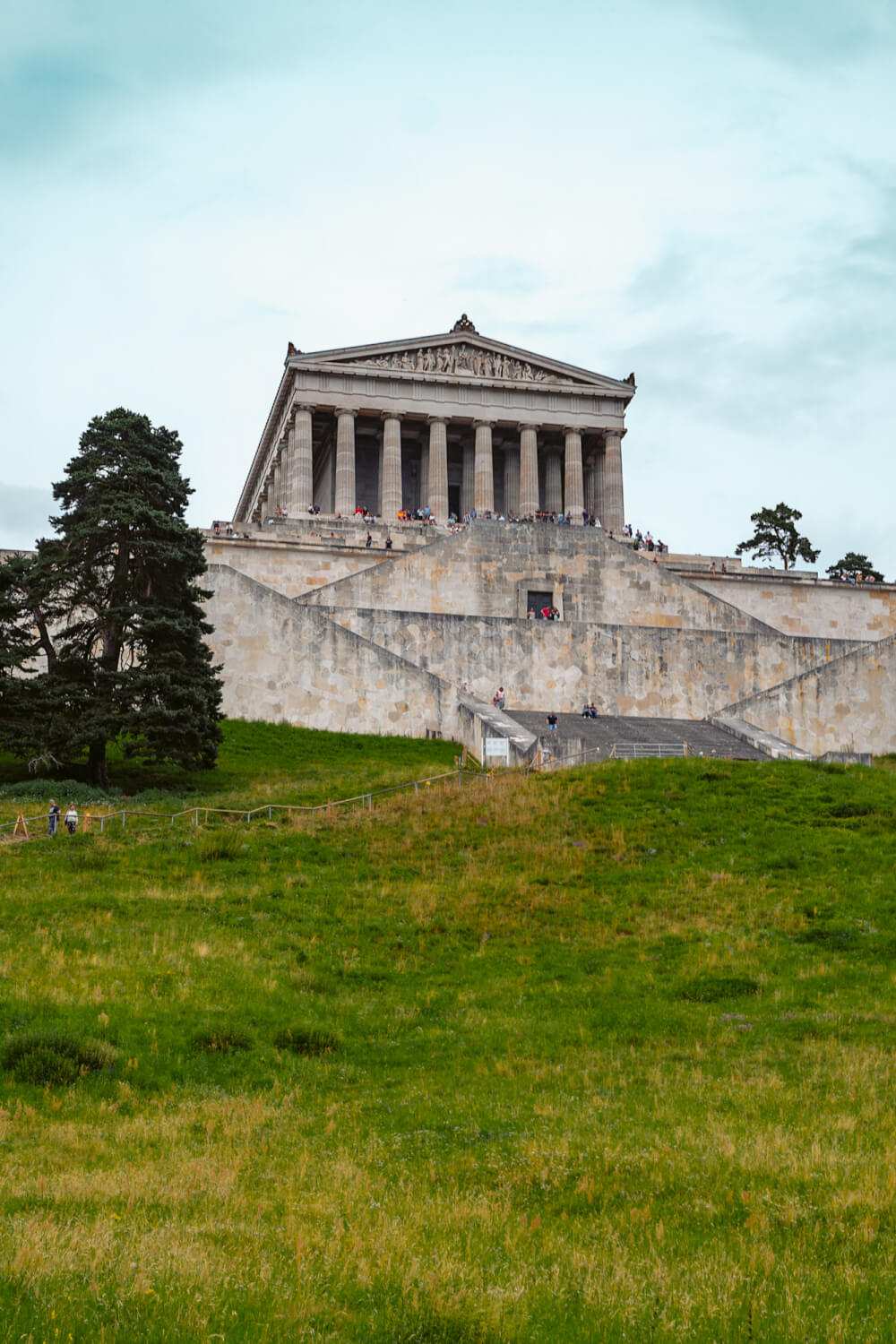
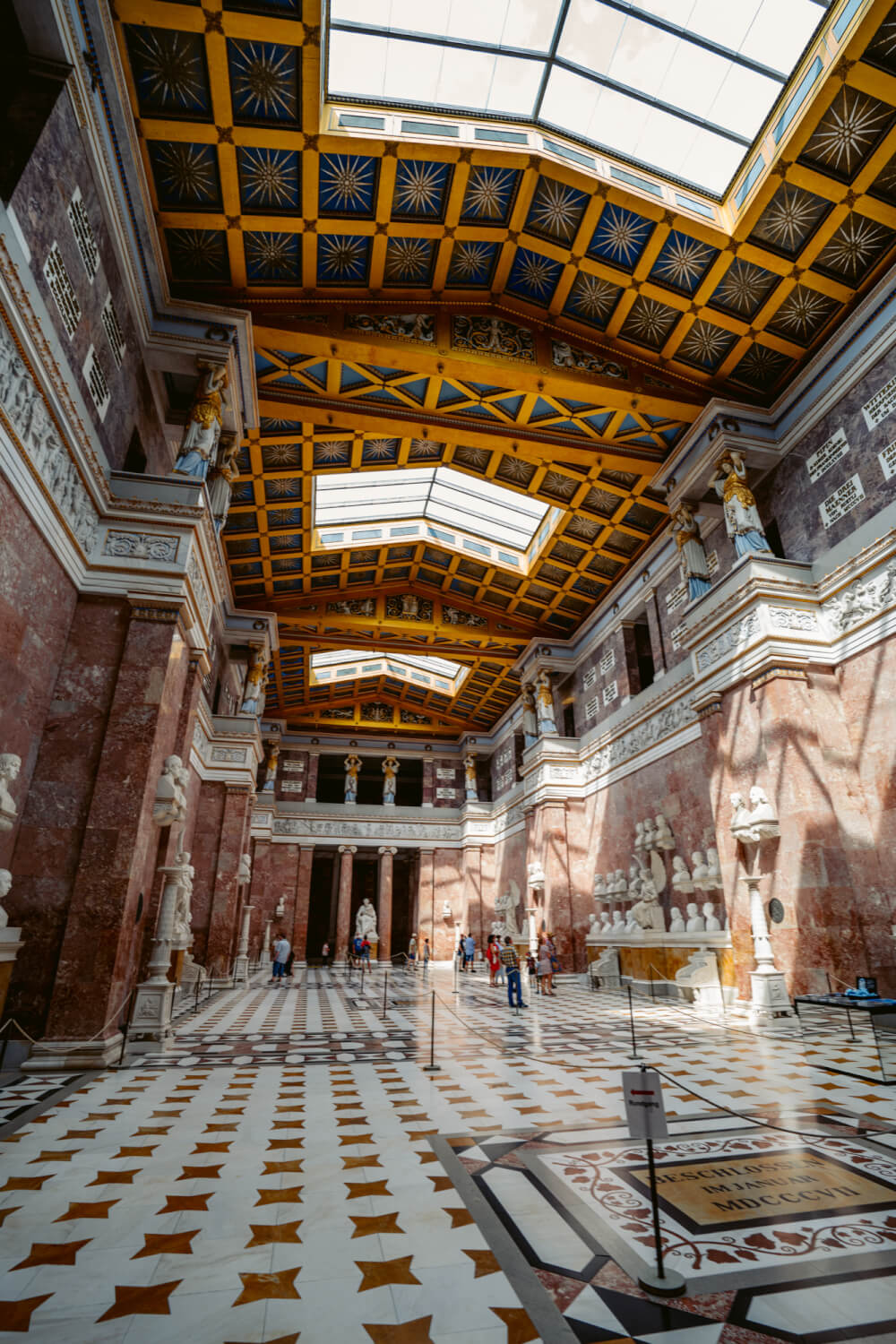
21. Hop on a Danube Cruise
Finally, if you want to experience Regensburg from a different vantage point, the best way would be to hop on a Danube cruise.
There are a variety of nice ones available, including:
- A sightseeing cruise to Walhalla: This cruise doesn’t stop at Walhalla but you can still get photos from onboard
- A city highlights cruise: This 45-minute cruise will enable you to see the highlights of Regensburg from the water
- A Bavarian landscapes cruise: This 3-hour sightseeing cruise heads all the way up the Danube to where it meets the Naab before turning around and going back again
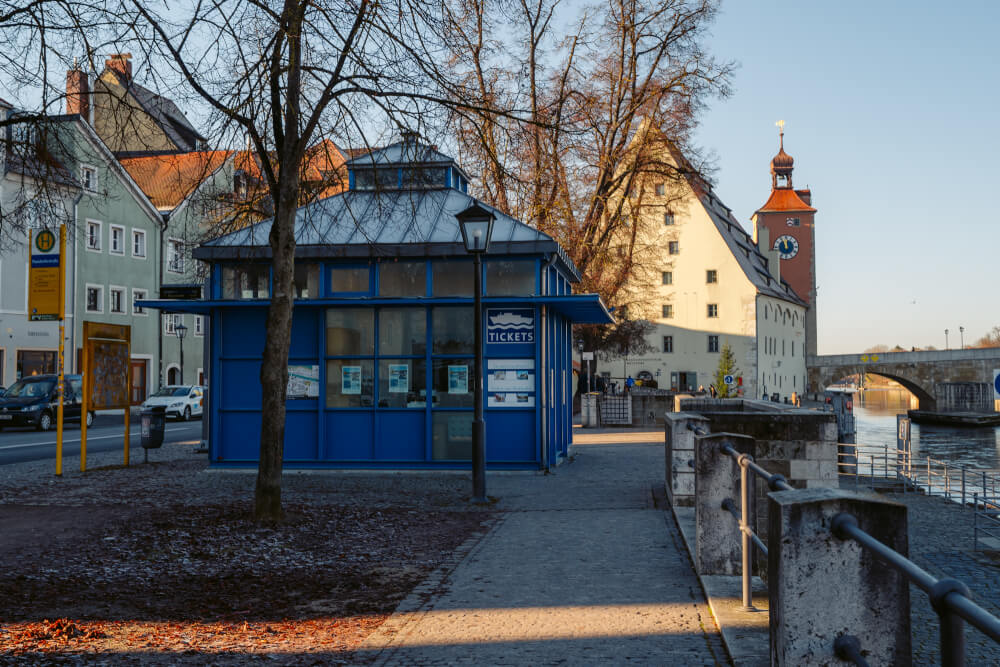
Did I miss any of your favourite things to do in Regensburg?
Let me know in the comments so I can add more of the best Regensburg activities to the list. Happy and safe travels! 🙂

